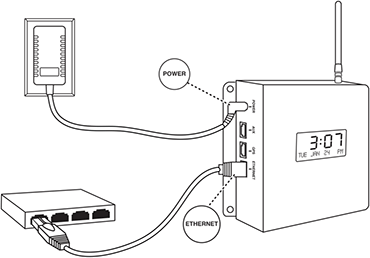Radio Frequency Wireless Synchronized Clocks
Synchronize your entire facility with dependable wireless timekeeping.



Time you can count on.
Radio Frequency (RF) Wireless Synchronized Clocks receive a dependable wireless time signal from an Ethernet-based transmitter centrally located within signal range of the clocks. Every clock is synchronized to a selected NTP time server, ensuring the accurate time is displayed throughout an entire building or complex.
RF Wireless Synchronized Clock Benefits

Wireless Communication
RF Wireless Synchronized clocks receive accurate time signals from a wireless transmitter, eliminating the need for
wiring.

Battery Operated
Battery operated analog and digital clocks provide ultimate flexibility and eliminate the cost of electrical installations.

No Signal Interference
RF Wireless Synchronized Clocks use the Frequency Hopping
Spread Spectrum (FHSS). The time signal "hops" from
frequency to frequency, ensuring the clocks will receive the correct time despite interference on any of the frequencies.

Official Time Data
RF Wireless Synchronized Clock Systems reference an official
time source.

No FCC License Required
If using a 1 watt or less RF Wireless transmitter, no FCC
license is required.

Automatic Daylight Saving Time
Forget about manual clock changes, RF Wireless
Synchronized Clocks automatically adjust for Daylight Saving
Time and power outages.
Simple Setup.
Simply plug the RF Wireless transmitter into
a standard electrical outlet and Ethernet port
to establish a network connection.
Once connected, synchronization software discovers
the transmitter and allows the user to choose
a time source, time zone, and Daylight Saving Time settings.
Upon power up, the RF Wireless Clocks search
for a time signal from the transmitter.

Find the perfect RF Wireless Synchronized clocks and accessories for your application.
Comply with regulations. Keep accurate time. Meet industry needs.

Here's a handy little guide with everything you need to know about Synchronized Clock Systems. Go beyond the basics and gain timely knowledge on:
Operational, economical and occupational benefits
Synchronization methods
System installation
Environmental performance factors
Industry-specific product applications
Still have a few lingering questions? Contact Us.
Improve punctuality and productivity.
Standardize work schedules, production shifts or class changes.











